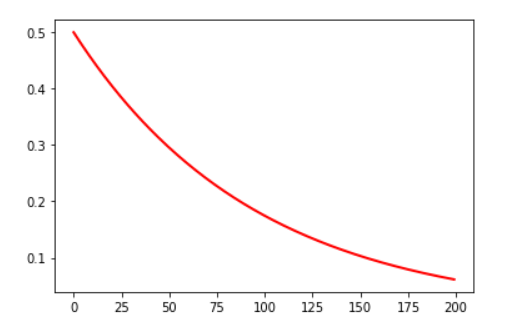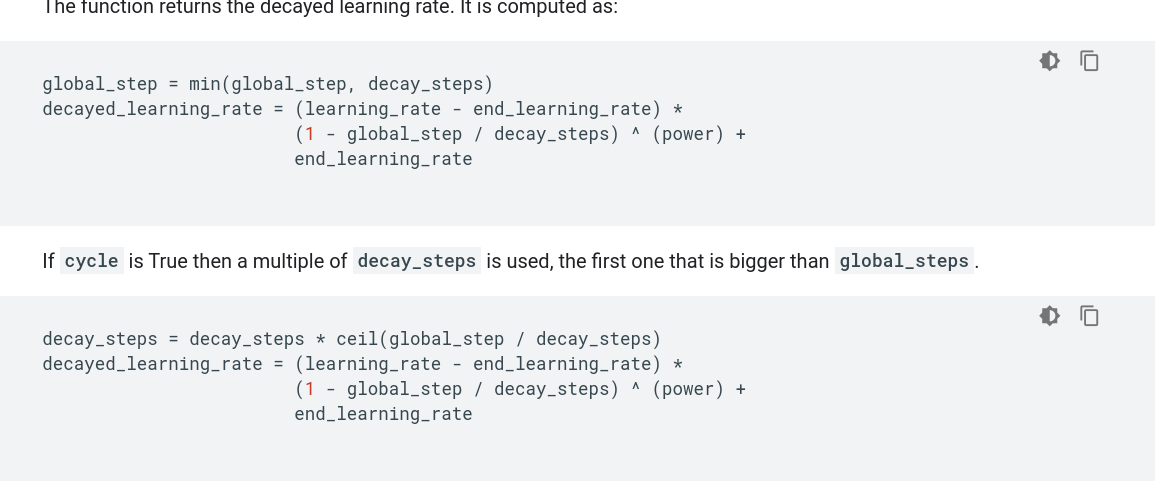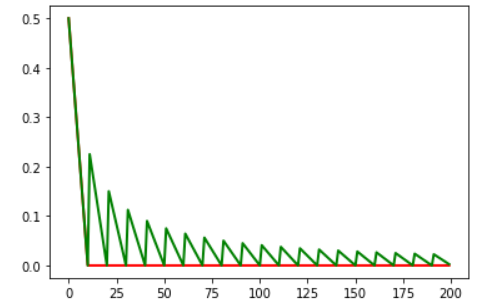tensorflow中的学习率调整策略
通常为了模型能更好的收敛,随着训练的进行,希望能够减小学习率,以使得模型能够更好地收敛,找到loss最低的那个点.
tensorflow中提供了多种学习率的调整方式.在https://www.tensorflow.org/api_docs/python/tf/compat/v1/train搜索decay.可以看到有多种学习率的衰减策略.
- cosine_decay
- exponential_decay
- inverse_time_decay
- linear_cosine_decay
- natural_exp_decay
- noisy_linear_cosine_decay
- polynomial_decay
本文介绍两种学习率衰减策略,指数衰减和多项式衰减.
tf.compat.v1.train.exponential_decay(
learning_rate,
global_step,
decay_steps,
decay_rate,
staircase=False,
name=None
)
learning_rate 初始学习率
global_step 当前总共训练多少个迭代
decay_steps 每xxx steps后变更一次学习率
decay_rate 用以计算变更后的学习率
staircase: global_step/decay_steps的结果是float型还是向下取整
学习率的计算公式为:decayed_learning_rate = learning_rate * decay_rate ^ (global_step / decay_steps)
我们用一段测试代码来绘制一下学习率的变化情况.
#coding=utf-8
import matplotlib.pyplot as plt
import tensorflow as tf
x=[]
y=[]
N = 200 #总共训练200个迭代
num_epoch = tf.Variable(0, name='global_step', trainable=False)
with tf.Session() as sess:
sess.run(tf.global_variables_initializer())
for num_epoch in range(N):
##初始学习率0.5,每10个迭代更新一次学习率.
learing_rate_decay = tf.train.exponential_decay(learning_rate=0.5, global_step=num_epoch, decay_steps=10, decay_rate=0.9, staircase=False)
learning_rate = sess.run([learing_rate_decay])
y.append(learning_rate)
#print(y)
x = range(N)
fig = plt.figure()
ax.set_xlabel('step')
ax.set_ylabel('learing rate')
plt.plot(x, y, 'r', linewidth=2)
plt.show()
结果如图:

- 多项式衰减
tf.compat.v1.train.polynomial_decay(
learning_rate,
global_step,
decay_steps,
end_learning_rate=0.0001,
power=1.0,
cycle=False,
name=None
)
设定一个初始学习率,一个终止学习率,然后线性衰减.cycle控制衰减到end_learning_rate后是否保持这个最小学习率不变,还是循环往复. 过小的学习率会导致收敛到局部最优解,循环往复可以一定程度上避免这个问题.
根据cycle是否为true,其计算方式不同,如下:

#coding=utf-8
import matplotlib.pyplot as plt
import tensorflow as tf
x=[]
y=[]
z=[]
N = 200 #总共训练200个迭代
num_epoch = tf.Variable(0, name='global_step', trainable=False)
with tf.Session() as sess:
sess.run(tf.global_variables_initializer())
for num_epoch in range(N):
##初始学习率0.5,每10个迭代更新一次学习率.
learing_rate_decay = tf.train.polynomial_decay(learning_rate=0.5, global_step=num_epoch, decay_steps=10, end_learning_rate=0.0001, cycle=False)
learning_rate = sess.run([learing_rate_decay])
y.append(learning_rate)
learing_rate_decay2 = tf.train.polynomial_decay(learning_rate=0.5, global_step=num_epoch, decay_steps=10, end_learning_rate=0.0001, cycle=True)
learning_rate2 = sess.run([learing_rate_decay2])
z.append(learning_rate2)
#print(y)
x = range(N)
fig = plt.figure()
ax.set_xlabel('step')
ax.set_ylabel('learing rate')
plt.plot(x, y, 'r', linewidth=2)
plt.plot(x, z, 'g', linewidth=2)
plt.show()
绘图结果如下:

cycle为false时对应红线,学习率下降到0.0001后不再下降. cycle=true时,下降到0.0001后再突变到一个更大的值,在继续衰减,循环往复.
在代码里,通常通过参数去控制不同的学习率策略,例如
def _configure_learning_rate(num_samples_per_epoch, global_step):
"""Configures the learning rate.
Args:
num_samples_per_epoch: The number of samples in each epoch of training.
global_step: The global_step tensor.
Returns:
A `Tensor` representing the learning rate.
Raises:
ValueError: if
"""
# Note: when num_clones is > 1, this will actually have each clone to go
# over each epoch FLAGS.num_epochs_per_decay times. This is different
# behavior from sync replicas and is expected to produce different results.
decay_steps = int(num_samples_per_epoch * FLAGS.num_epochs_per_decay /
FLAGS.batch_size)
if FLAGS.sync_replicas:
decay_steps /= FLAGS.replicas_to_aggregate
if FLAGS.learning_rate_decay_type == 'exponential':
return tf.train.exponential_decay(FLAGS.learning_rate,
global_step,
decay_steps,
FLAGS.learning_rate_decay_factor,
staircase=True,
name='exponential_decay_learning_rate')
elif FLAGS.learning_rate_decay_type == 'fixed':
return tf.constant(FLAGS.learning_rate, name='fixed_learning_rate')
elif FLAGS.learning_rate_decay_type == 'polynomial':
return tf.train.polynomial_decay(FLAGS.learning_rate,
global_step,
decay_steps,
FLAGS.end_learning_rate,
power=1.0,
cycle=False,
name='polynomial_decay_learning_rate')
else:
raise ValueError('learning_rate_decay_type [%s] was not recognized' %
FLAGS.learning_rate_decay_type)
推荐一篇:https://blog.csdn.net/dcrmg/article/details/80017200 对各种学习率衰减策略描述的很详细.并且都有配图,可以很直观地看到各种衰减策略下学习率变换情况.

